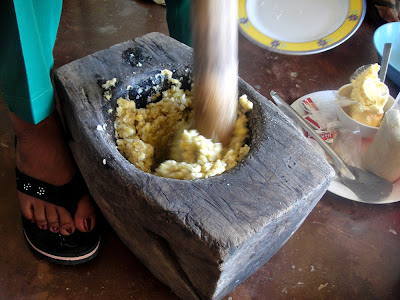I mentioned in my previous blog posts that Siruma is a coastal island, meaning it’s beside the sea. And because of that, there are so many seafoods you could buy if the fishermen’s were able to catch said seafoods. If the waves are too high or too strong, they are not able to go out to fish thereby no seafoods available.
My first night at Siruma (way back last March 2012), my staff surprised me with a huge food feast. They bought squids (pusit) and cooked them in 3 different ways: fried calamares, inihaw (grilled), and adobo. It was heaven! The squid was so fresh it tasted different then the squids we have here in Manila. 1 kilogram of squid there costs only 120php!
There are also a lot of different varieties of fishes sold, such as Lapu-Lapu, Maya-Maya, etc. 1 kilogram of these ranges from 90php-150php. There also fresh crabs (90php/1kg) and shrimps, sometimes even giant shrimps (sugpo). These all ranges from 100php-150php per 1kg, which is really, really cheap! And even though it’s cheap, it’s still very delicious since it’s freshly caught. There are also little scallops for sale which is just 20php per plastic, just boil them, team it with toyo (soy sauce) and voila, instant dinner/merienda/lunch.
A personal favorite of mine would be the “kinunot na pagi” (in English, sting ray). Whenever I go back to Siruma, I look for this, and my staff cooks it with coconut milk (gata), and kang kong. It is amazing! If you’re a bit squeamish, then you should not look at the pagi when it’s not yet cooked, other than that, it’s really, really yummy!
Now, if the waves are strong and there are no sea foods available, you could still choose a lot of variety of foods from plants which is just in their backyard. I was able to try fresh kamote straight from the soil and then just boiled in around an hour or so, and it was very tasty. Banana-ques are frequently seen as well (this are bananas with sugar and then fried). And let’s not forget the famous “Laing” which are gabi or taro leaves cooked in coconut milk (gata). Another favorite of mine when there is no available sea foods would be the “Ginataang Puso ng Saging” (banana heart cooked in coconut milk).
Another new food that I was able to try was fried chicken. Yes, not exactly unique or new, but this is different because the chicken used was a “native” chicken (which they said is tastier compared to chickens usually sold in the market) and it was unique for me because I was part of the group that “killed” the chicken. And yes, it was morbid. But then, it was very delicious after haha.
A favorite merienda of my staff would be the “Nilupak/Linupak” which is technically, green bananas crushed in a mortar and pestle together with peanuts, brown sugar, shredded coconuts. Later on, it is topped with margarine and more crushed peanuts. It’s not really a favorite of mine because it’s too heavy in the stomach but still it’s a yummy treat. Another merienda usually done by my staff is “Pansit” with little shrimps in it. Again, it’s very delicious. We were also able to cook our own pancake from scratch, not those pancakes from boxes which is already flavored. It was a bit weird tasting but still edible haha.
If you’re lucky, in the afternoon, there are some selling ice creams (dirty ice creams) and squidballs, fishballs, kikiam. But this is a bit of a rare commodity. Usually seen only of there are activities in the area.
And that's the different foods I was able to try in my stay there. The fun part about this all of these are either very cheap, or for free. No problem at all in buying it. And they are all fresh!
Next, the summary!
Read more:
Surviving Siruma: An Introduction To An Unknown Island
Surviving Surima: Where to Stay and Places to Visit
Surviving Siruma: The Town Fiestas
Surviving Siruma: Things To Do in Siruma
Surviving Siruma: A Summary



























No comments:
Post a Comment